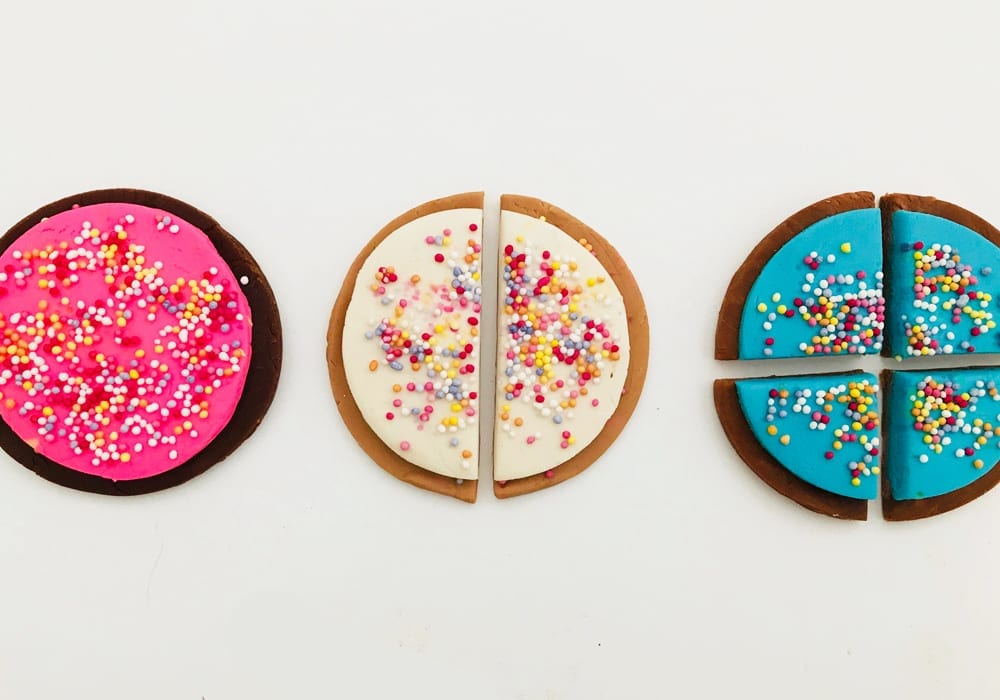Playtime Learning | Fractions Activities
Teaching Fractions with Playdough Cookies
Make it clear what fractions are by showing kids visually with these playdough cookies. This play activity helps you to start teaching fractions in an interactive way. It uses fractions activities to break down each stage into bitesize chunks.
Stage 1:
- Children will learn what the concept of a ‘whole’ is.
- They will learn what a half is. And count the halves that make up a whole.
- They will learn what a quarter is. How many quarters make up a whole?
- They will learn how to write out a fraction.
Stage 2:
- Your child will learn that a ‘whole’ can be any number of things. A whole cake, a whole banana, or a whole number of items.
- They will learn to divide a ‘whole’ number into a ‘half’ or a ‘quarter’ using our cookie mats as a guide.
Summary:
Time: 15 minutes
Age: Big Kids
Difficulty to make: Easy peasy
Skill: Learning First Fractions

You will need:
Our free printable fraction worksheets
- Stage 1: Introducing Fractions. Playdough cookie mat.
- Stage 2: Add Fractions. Playdough cookie mat.
- Stage 3: Write Fractions. Worksheet.
Playdough cookie making tools
- Play dough or modelling clay
- Rolling pin
- Round cookie cutter
- Rainbow sprinkles (optional)
- Play dough knife
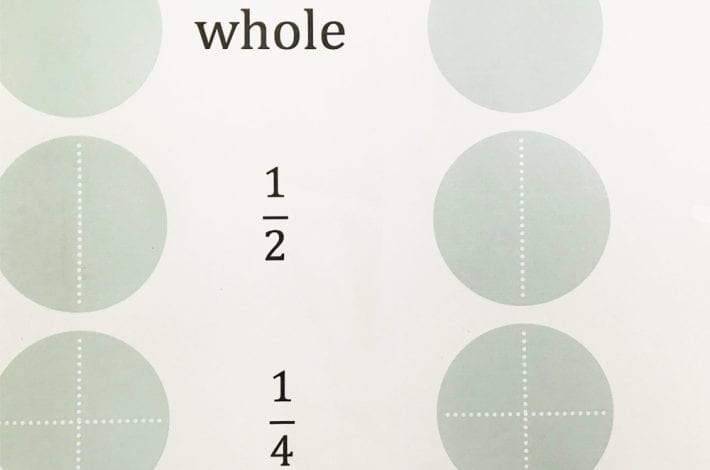
Step 1: Download our free fraction activities mats
Print out our FREE fraction activities mats. They show how a cookie can be divided into 2 halves or into 4 quarters. They can help with teaching fractions by guiding your child through the different stages.
- Stage 1: Introduce Fractions. Playdough cookie mat.
- Stage 2: Write Fractions. Worksheet.
- Stage 3: Add Fractions. Playdough cookie mat.
When you’re teaching fractions remember to use simple language and repeat the same terms.
Say ‘whole’, ‘half’ and ‘quarter’ a few times to reinforce these new words and what they mean.
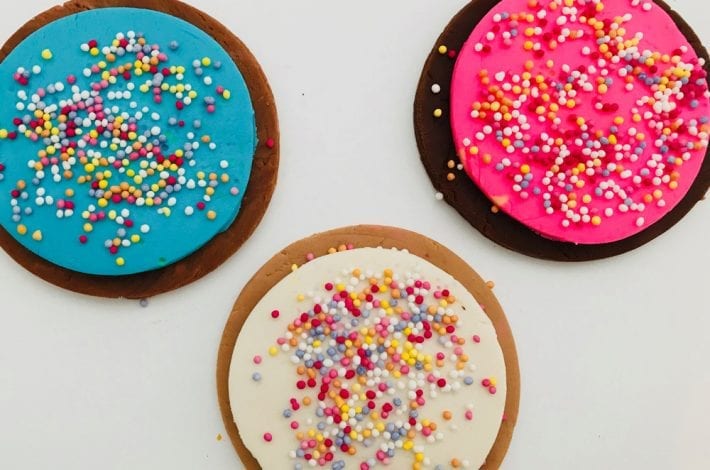
Step 2: Make your biscuits
Roll out your play dough and cut it into circles with a cookie cutter. Make them about the same size as the circle on your printable fractions activities mat. These will be your cookies.
Then take a different coloured playdough. Roll it out and cut slightly smaller circles with a cookie cutter or playdough knife. These will be your icing layers. Place them on top of your cookies.
If you like you can scatter colourful sprinkles on top. Make a few cookies before you start with the fractions activities.
Do note that while these biscuits look good enough to eat, they’re still made of playdough. So remind your child not to take a nibble!



Introduce the ‘whole’
Explain that one biscuit is a whole. That’s the name we use in maths to talk about a complete shape or set.
A whole could be a number of things, not just a cookie. You could have a whole pizza, a whole cake, a whole apple, a whole chocolate bar.
Begin with the first worksheet: Stage 1: Introducing Fractions. Your child can place their biscuit onto the first circle, next to the word ‘whole’.
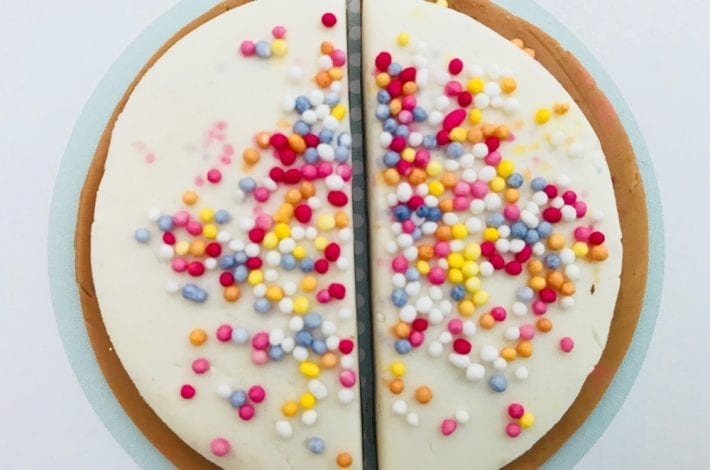

Fractions Activity: Make 2 halves
Now tell your child that you want them to share their biscuit with you. But you both want exactly the same sized pieces (because otherwise it’s not fair!).
Help your child put the knife down the centre of the biscuit, to cut it into 2 equal halves.
Explain that when you split a cookie into 2 equal parts, each part is called a half.
You get half a biscuit each.
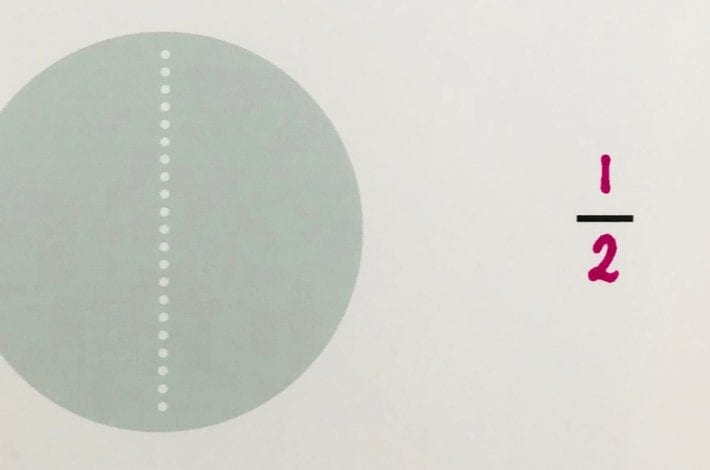

Write Out Fractions
Explain that we write this concept of a half as a fraction like this: ½.
Your child can look at the second worksheet: Stage 2: Write Fractions. There are spaces where they can write out the fractions that are shown with each shape.
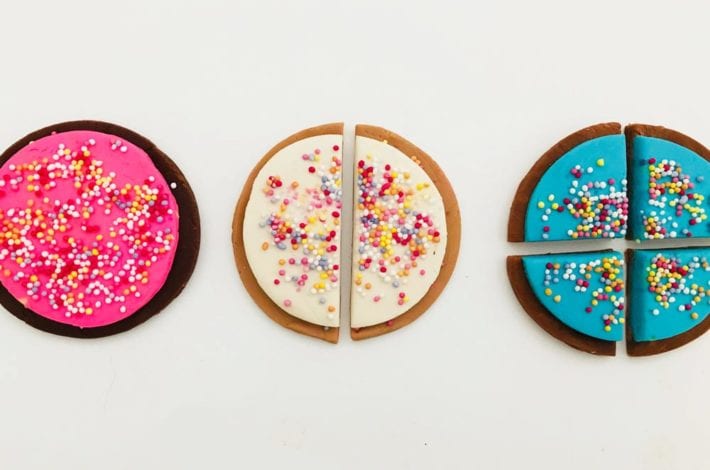

How many halves make a whole?
Move onto Stage 3: Add Fractions.
Your child can place the pieces of biscuit on the worksheet, putting one half on each side.
Ask your child what would happen if you glued the two halves of biscuit back together. What would they end up with? A whole biscuit again.
The two halves cover the whole circle to make a whole.
Can they see that 1/2 and 1/2 make a whole?
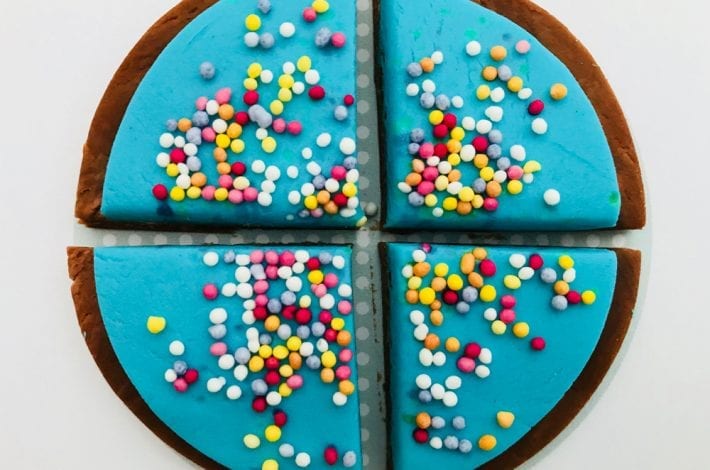

What is a quarter?
Take another whole cookie and return to the first printable. Stage 1: Introducing Fractions.
Now tell your child that they need to share their biscuit equally between four people. Can they see how they might cut it into four pieces?
Show them how to cut it across the centre to make four equal pieces.
Now one whole biscuit has been shared equally between four people. Everyone gets a quarter each.
Explain that when we split a whole into four equal pieces, each piece is called a quarter.
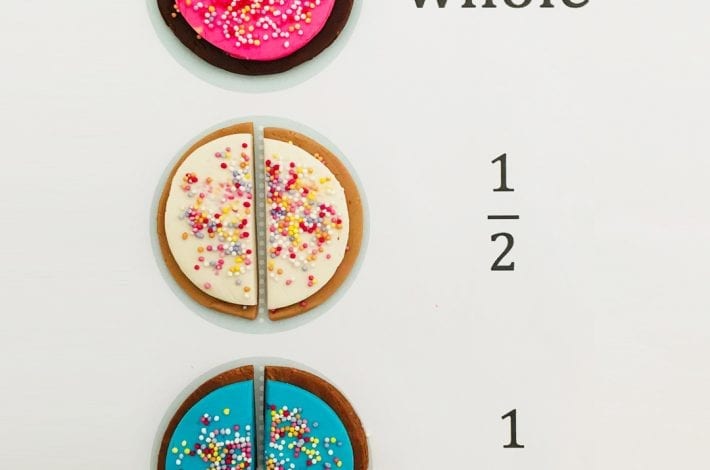

How many quarters make a whole?
Now ask your child to place four quarters of biscuit on the circle on the worksheet.
What would happen this time if they glued the four pieces back together? Can they see that they would have a whole biscuit again?
So ¼ and ¼ and ¼ and ¼ make a whole.
Count out how many quarters make a whole? It’s 4 quarters.
Write out the fraction
Return to the second worksheet: Stage 2: Write Fractions. Show them how we put the number 4 at the bottom of the fraction this time to write out ¼ as a fraction.
They could remove all pieces of their biscuit and write 1/4 on each segment of the circle to practice writing out this fraction.


Extend the Fraction Activity: Two quarters make a half
At first little kids can just have lots of fun cutting up their play dough biscuits into halves and quarters. You don’t even have to use the worksheets.
You could just introduce them to the words, ‘whole’, ‘half’ and ‘quarter’. At first you could even write the fractions on flashcards until they feel comfortable with the concept of halves and quarters.
When you’re ready to move on you can use the third playdough mat again, Stage 3: Add Fractions. This time you can use it to show how different fractions can be added together.
Ask your child to cover ½ of a circle with a half of biscuit. Then cover the other half with 2 quarter pieces.
Both sides of the circle are the same size. But one side has been cut in half. The half slice is the same size as 2 quarter slices.
Explain that ¼ and ¼ is the same as ½. Two quarters are the same as one half.
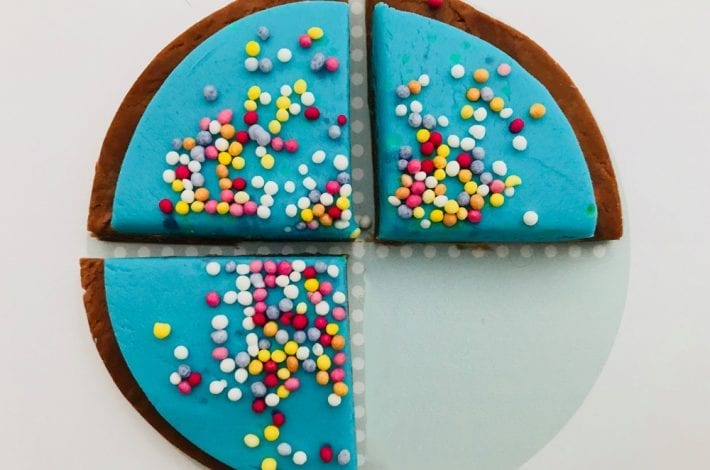

Three quarters
You can also ask your child to place three quarter slices of biscuit on the circle. Explain that they have covered three quarters of the whole shape.
The bottom number of the fraction stays the same (4) as the shape has been divided into 4 pieces. However this time you don’t just have 1 of these pieces, you have 3 of them. So the fraction is written as ¾.
Keep playing around with different combinations until your child becomes familiar with what a fraction means and how to add some fractions together.
For example, if you have one quarter and you add another two quarters what do you get?
The Cookie Shop Fractions Game
Role play 1: The Very Particular Customer
You could play a little game, pretending your child has a cookie shop and you are the customer.
Ask the cookie shop owner for different portions of a biscuit. You could ask for 2 halves, or 2 quarters. Or for 1 half for you and 1 quarter for your pet dog.
Your child can cut the cookie for their ‘picky customer’. They can then add up how much of the cookie they are giving you altogether.
Role Play 2: The Customers Who Like To Argue
You could play biscuit shops again and pretend to be two customers. One asks for half a biscuit. The other asks for 2 quarter pieces. Pretend to argue about who has got the most.
The first customer could say he has got the biggest piece, so he must have the most.
The second customer says that’s not true. He has TWO pieces of biscuit. So he must have the most. Can your child settle the argument and work out who has the biggest bit of biscuit?
Remember though that adding up fractions can be a tricky concept, so don’t worry if your child doesn’t get it right all the time. Just have lots of fun playing around with it and cutting your cookies into halves and quarters.
Fractions and Division
Once your child has played around with their cookies and become familiar with the concept of halves and quarters you can extend the fractions activity.
Introduce the idea that a ‘whole’ can be a whole ‘set of something’. For example a ‘whole’ could be a ‘whole basket of 8 oranges’. In this way you introduce a number as the ‘whole’.
Use playdough balls to keep the learning fun and easy to understand.
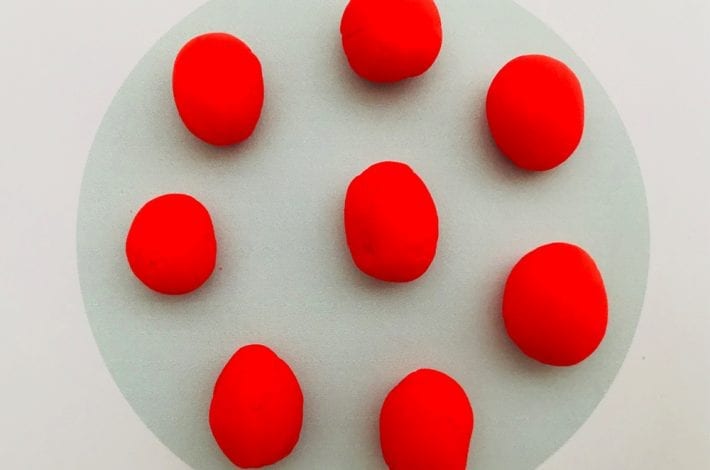

Start with a whole number
Ask your child to roll out 8 little balls of play dough. These could be 8 strawberries or 8 sweeties, whatever they would like them to be.
Ask them to place all 8 balls on the top circle of the first worksheet, Stage 1: Introducing Fractions.
To make sure they have 8 sweets ask them to count them to check. The whole jar has 8 sweets in it.
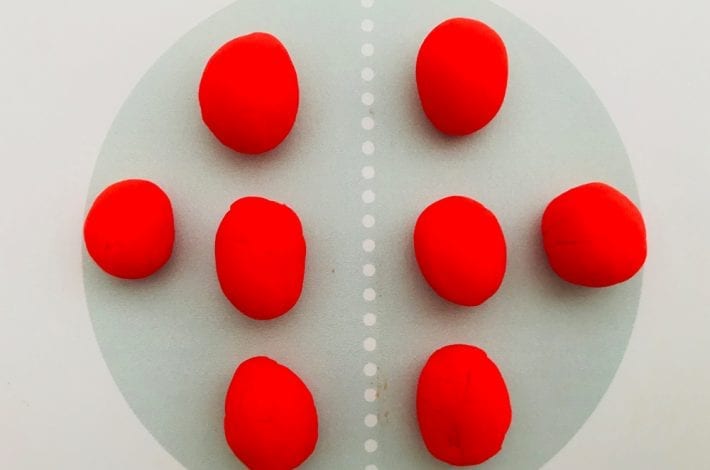

Dividing the number by half
Now move down to the next circle. Ask your child to share the 8 balls between the two halves of the next circle on their worksheet.
Remind them that they must share the balls equally between the two sides of the circle. To help them do this they can take turns adding 1 ball to each side of the circle, until they’re finished.
Are there the same number of balls on each side?
How many balls are there on each side?
Explain that when they shared the balls between the two halves, they ended up with 4 balls on each side. So 1 half of 8 is 4.
They could write the number 4 on each side of the circle. This could show them that when they shared the 8 balls between two sides, they ended up with 4 balls on each side.
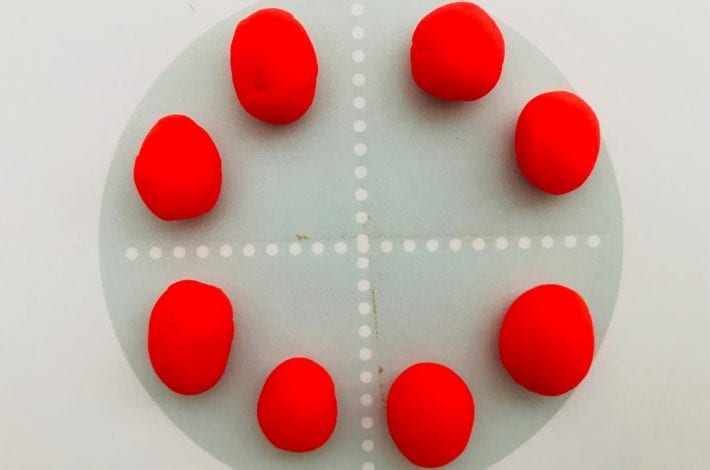

Dividing 8 into quarters
Now ask your child to share the 8 balls between the four quarters of the next circle on their worksheet. Remind them that they must share the balls equally between the four segments of the circle.
How many balls are in each quarter?
Explain that when they shared the balls between the 4 quarters, that they ended up with 2 balls on each segment. So one quarter of 8 is 2.
They can write the number 2 on each segment of the circle. This will show them that when they share the 8 balls between 4, they ended up with 2 balls each.
Fractions Game: The Sweet Shop
You can reinforce the concept of dividing numbers by playing imaginary games with your child.
Pretend they run a sweet shop. As a customer ask them to share all the sweets that they have between you and your friend.
They can count out the sweets into two piles. How many do you get each?
If they had 12 sweets and shared them between 2 people, you both got 6 sweets. Half of 12 is 6. You could repeat the game by asking them to share the sweets between 4 people.
Keep Fractions Activities Fun
Fractions are a tricky concept to learn at first. Breaking them down into smaller stages and chunks can help your child understand them more easily.
Use fun and visual activities to help them understand what each fraction actually means.
Make up any fun scenarios you like to help make it a game! From sharing out a basket of apples between friends, to cutting up a cake so that everyone in their family gets an equal slice.

